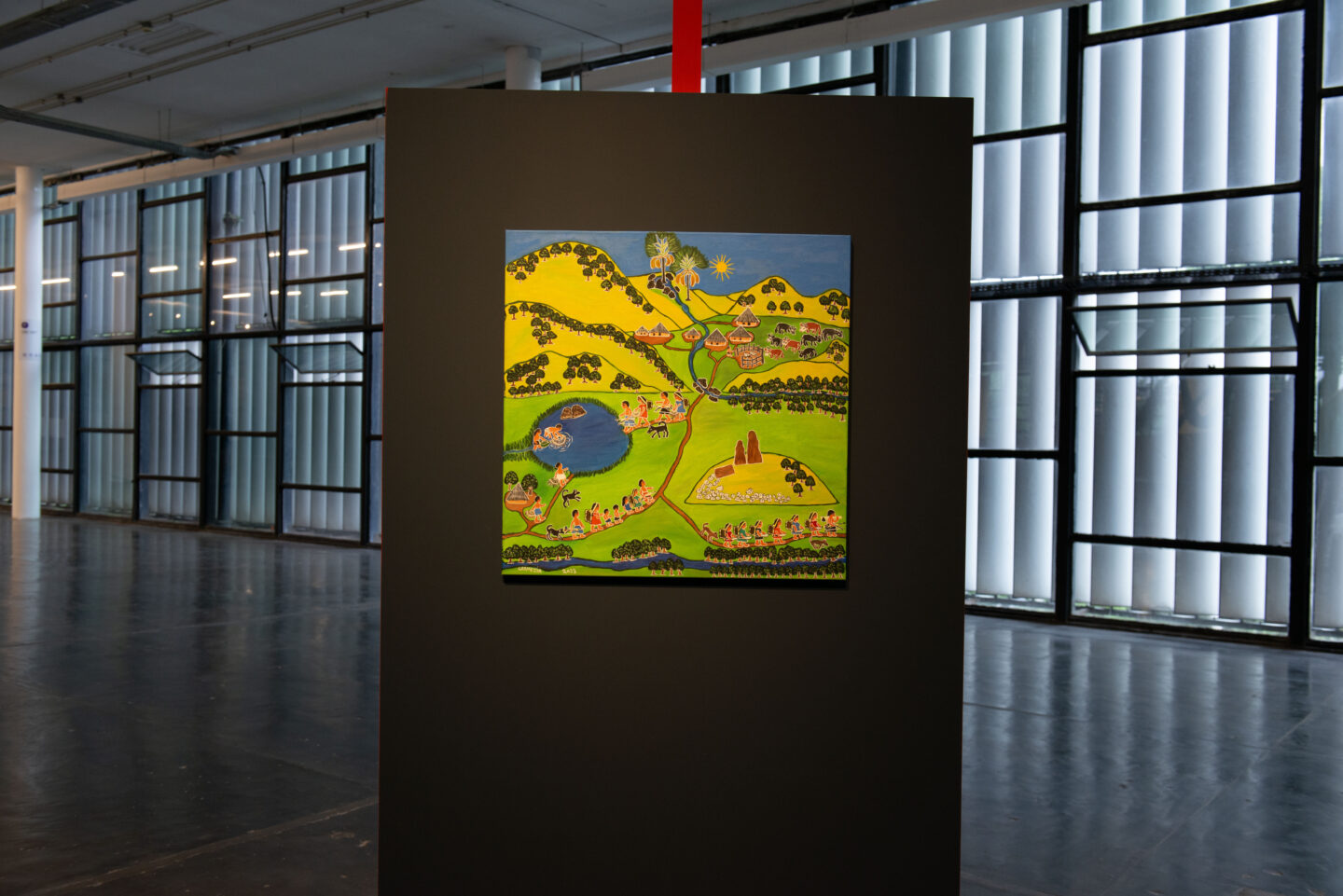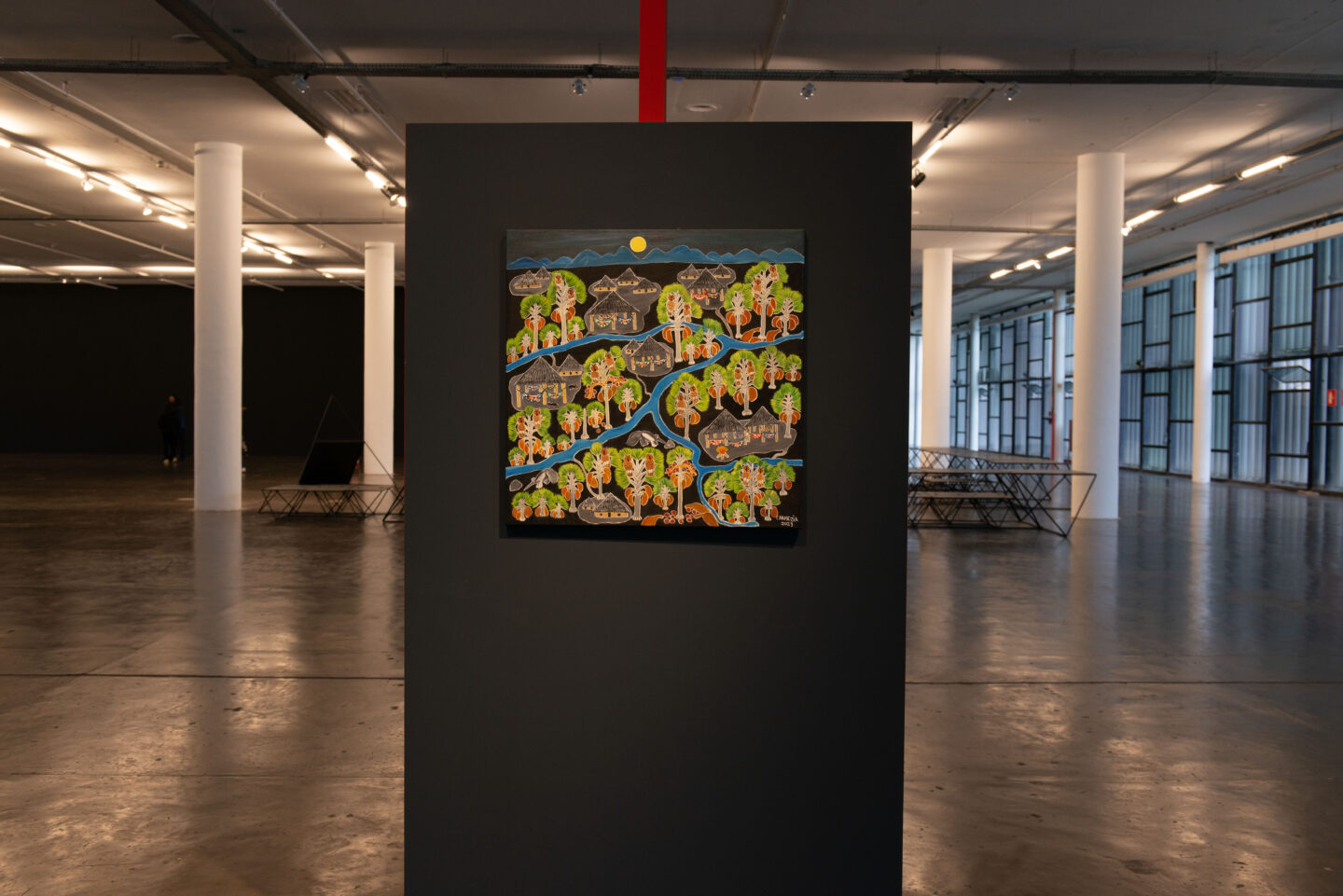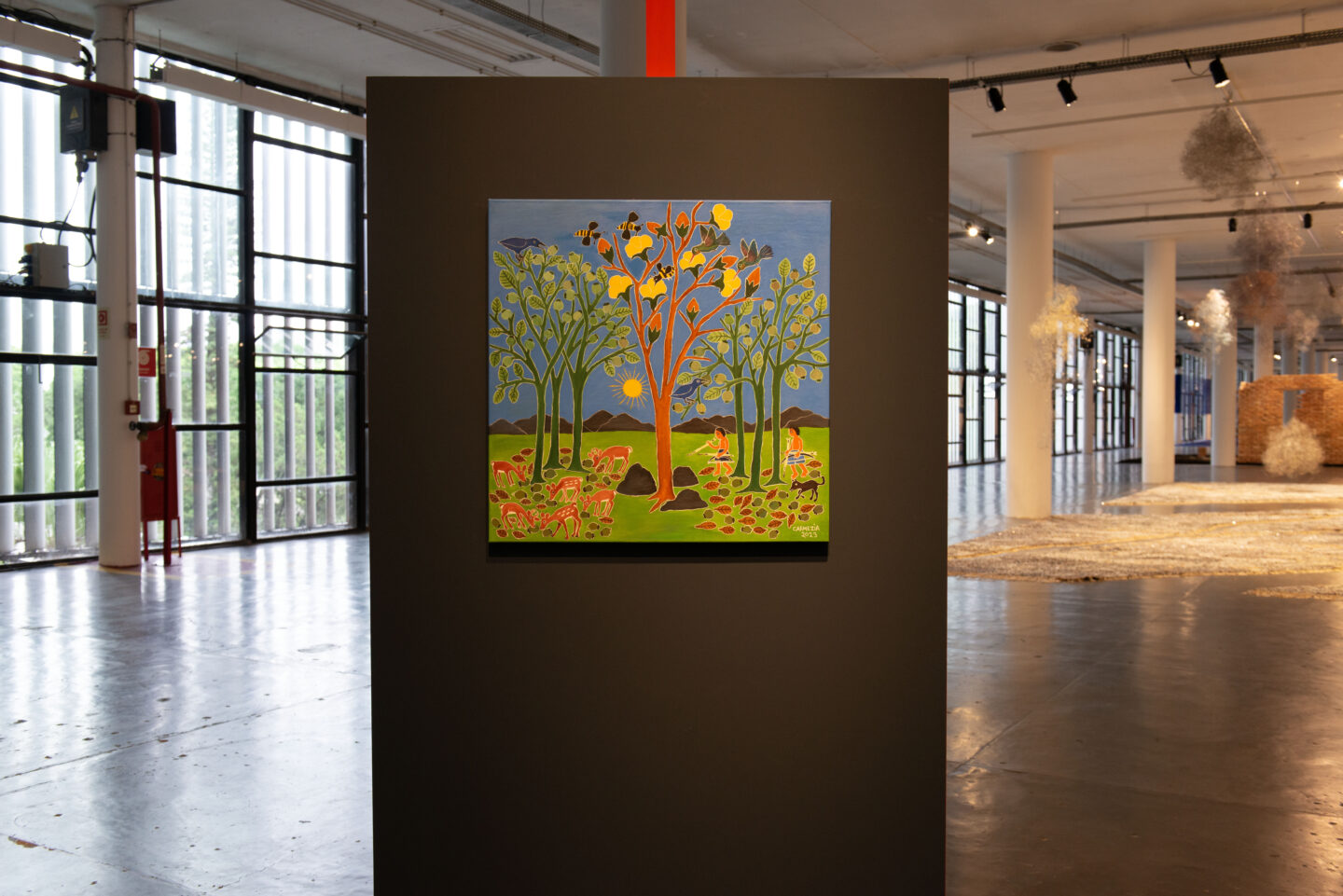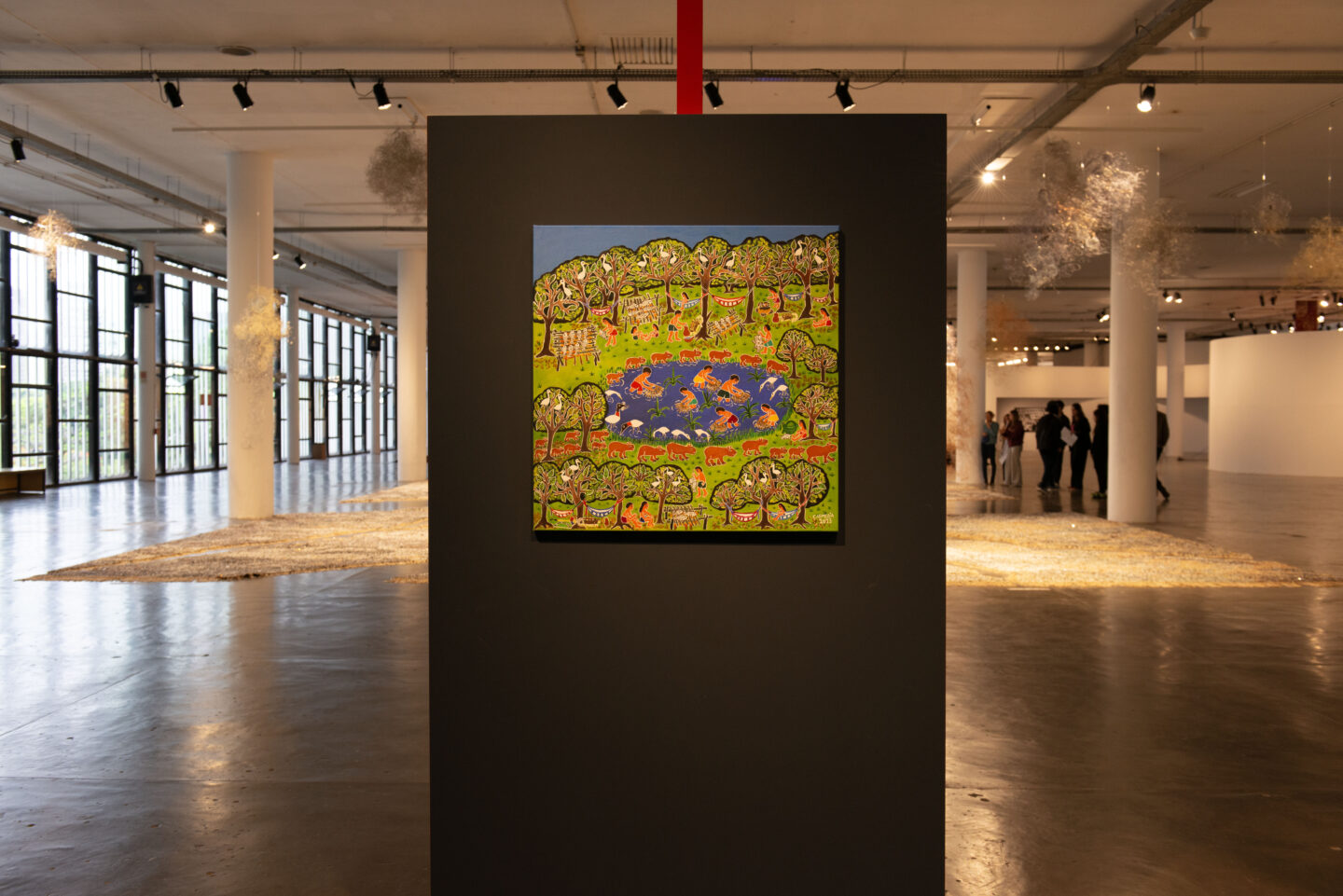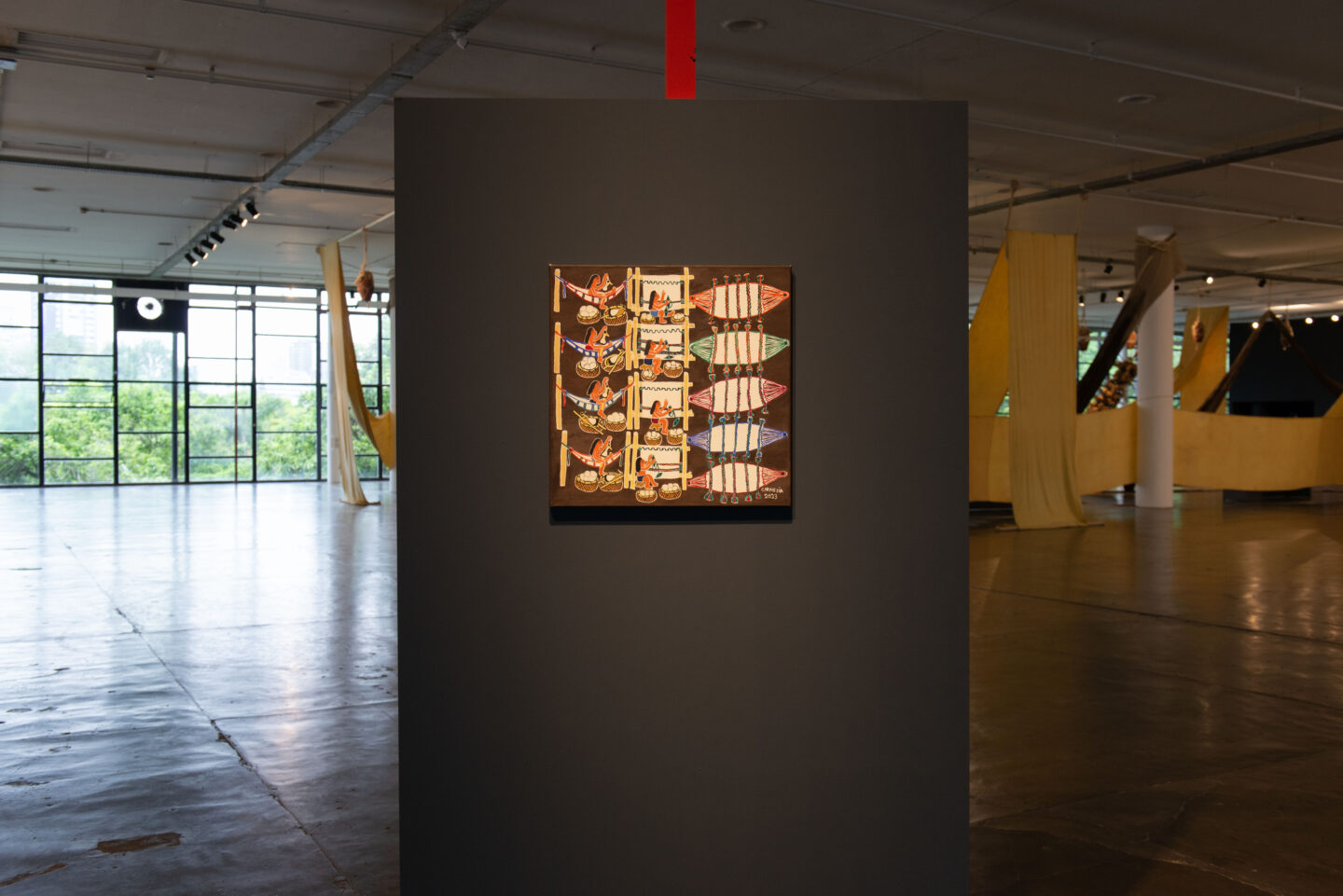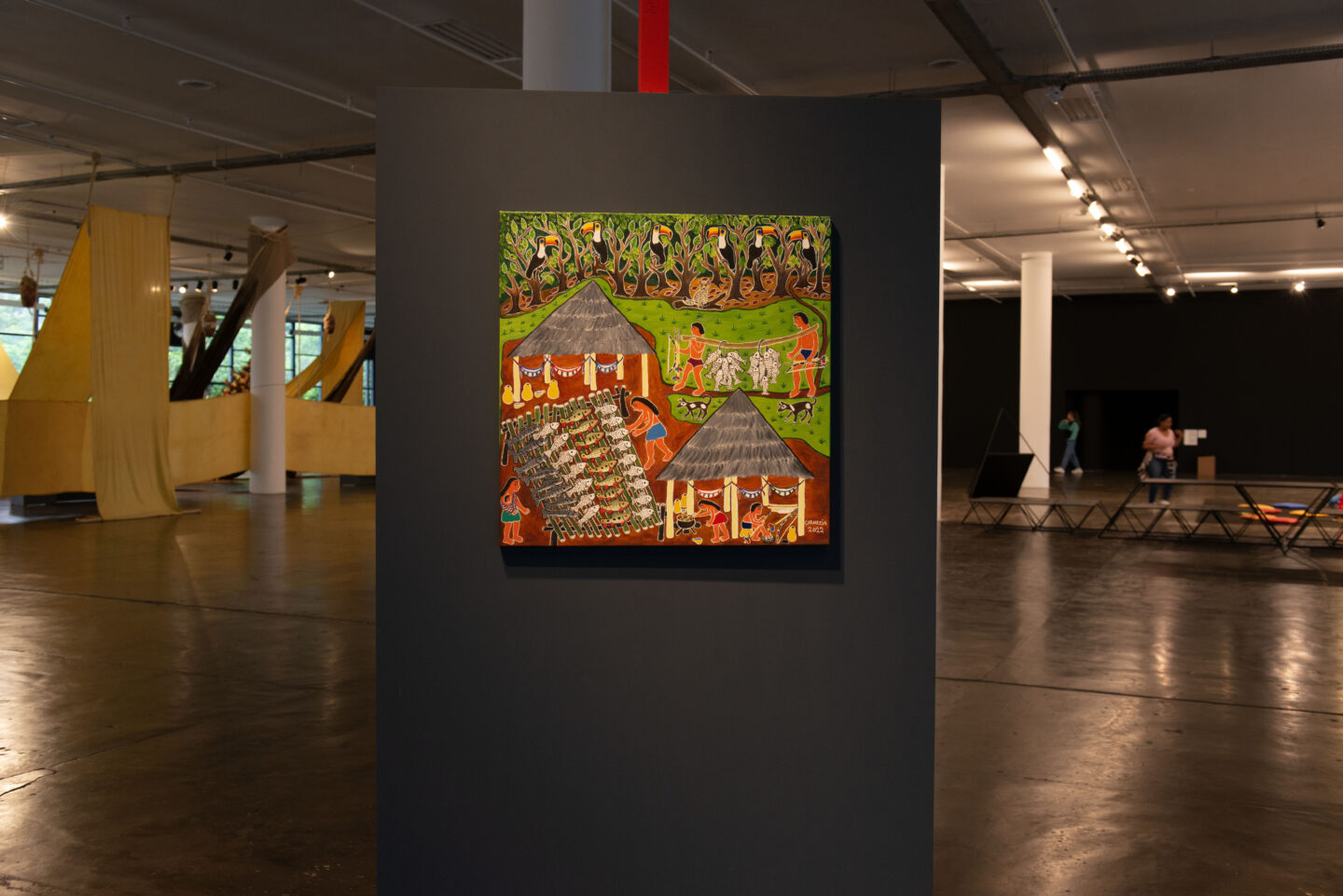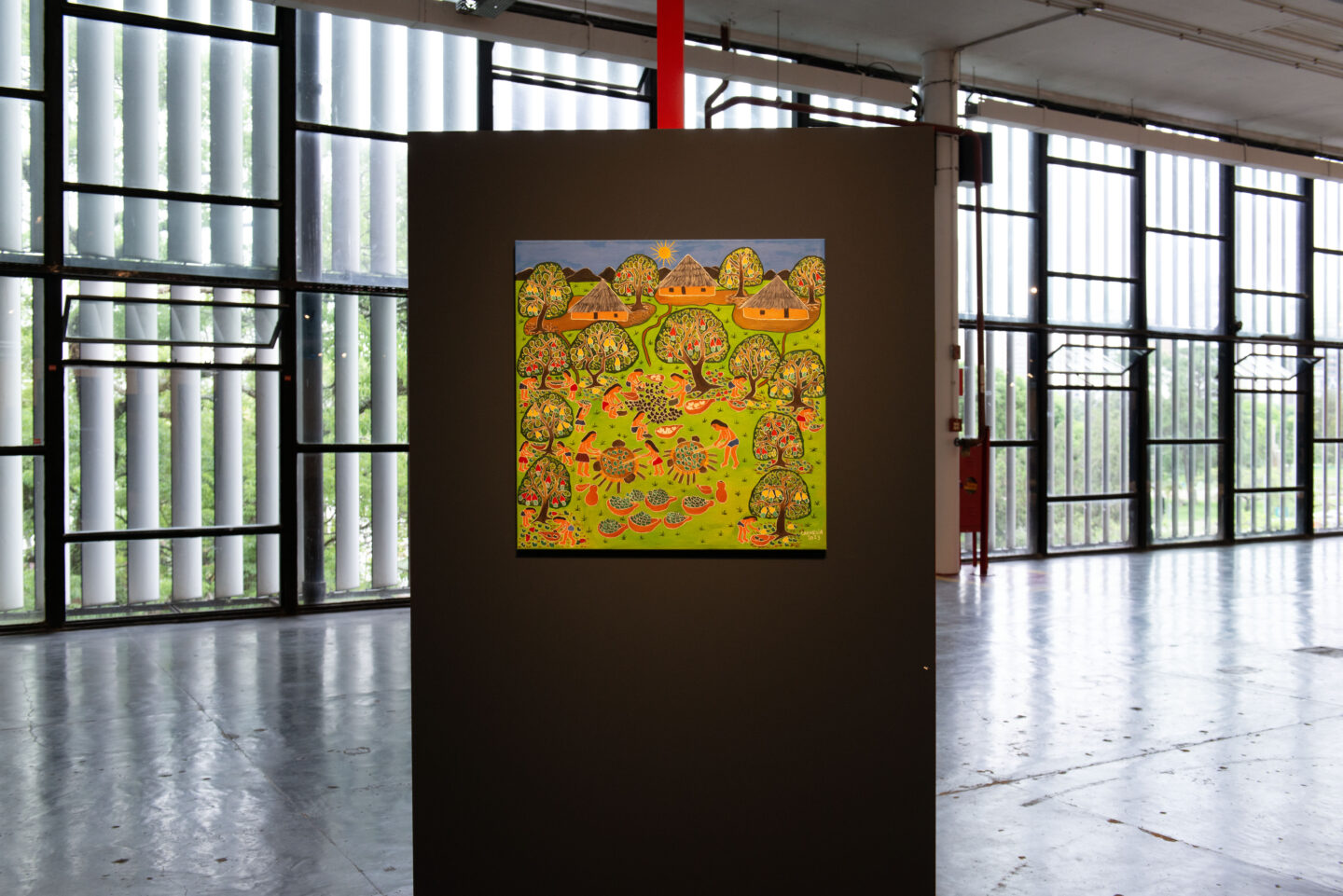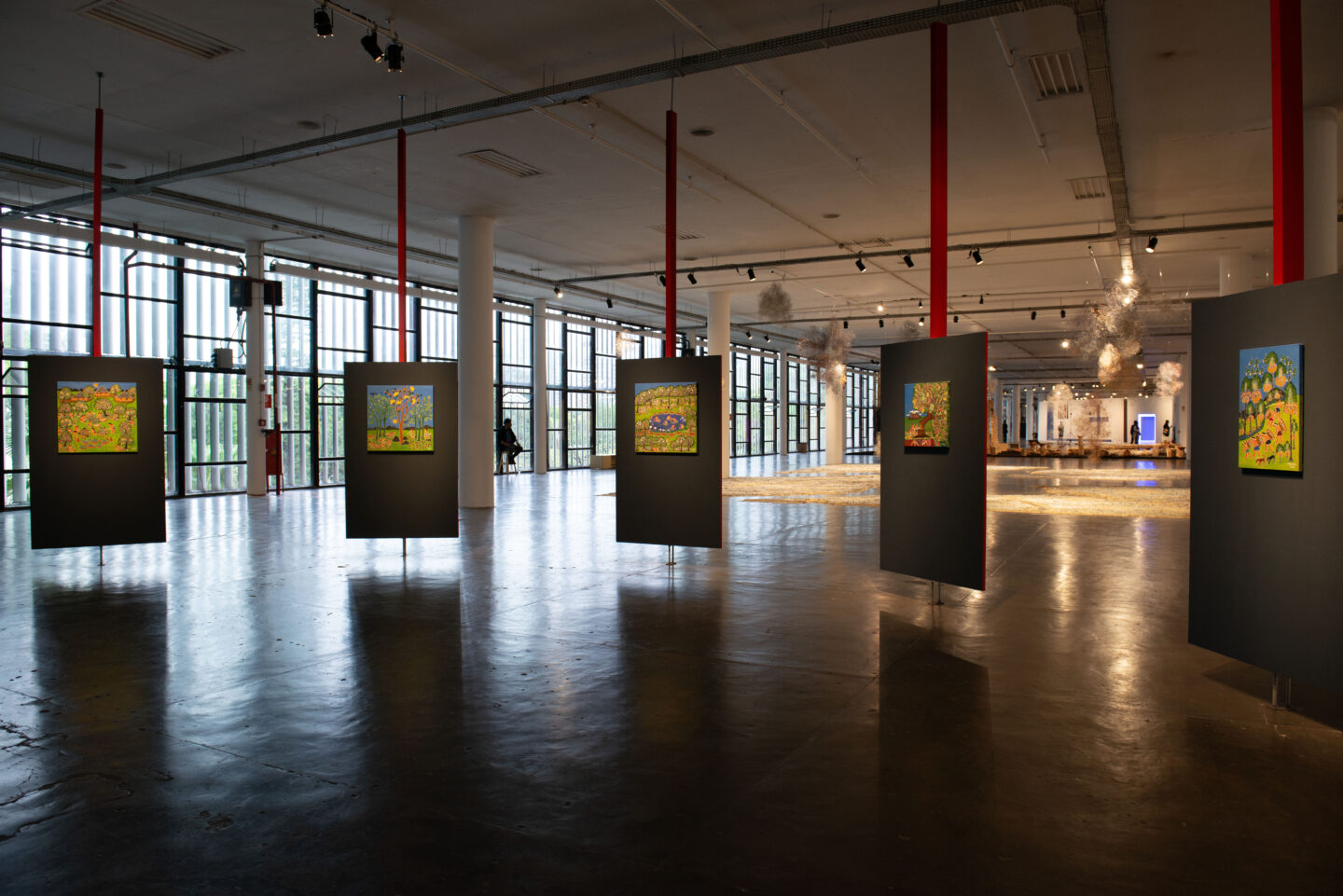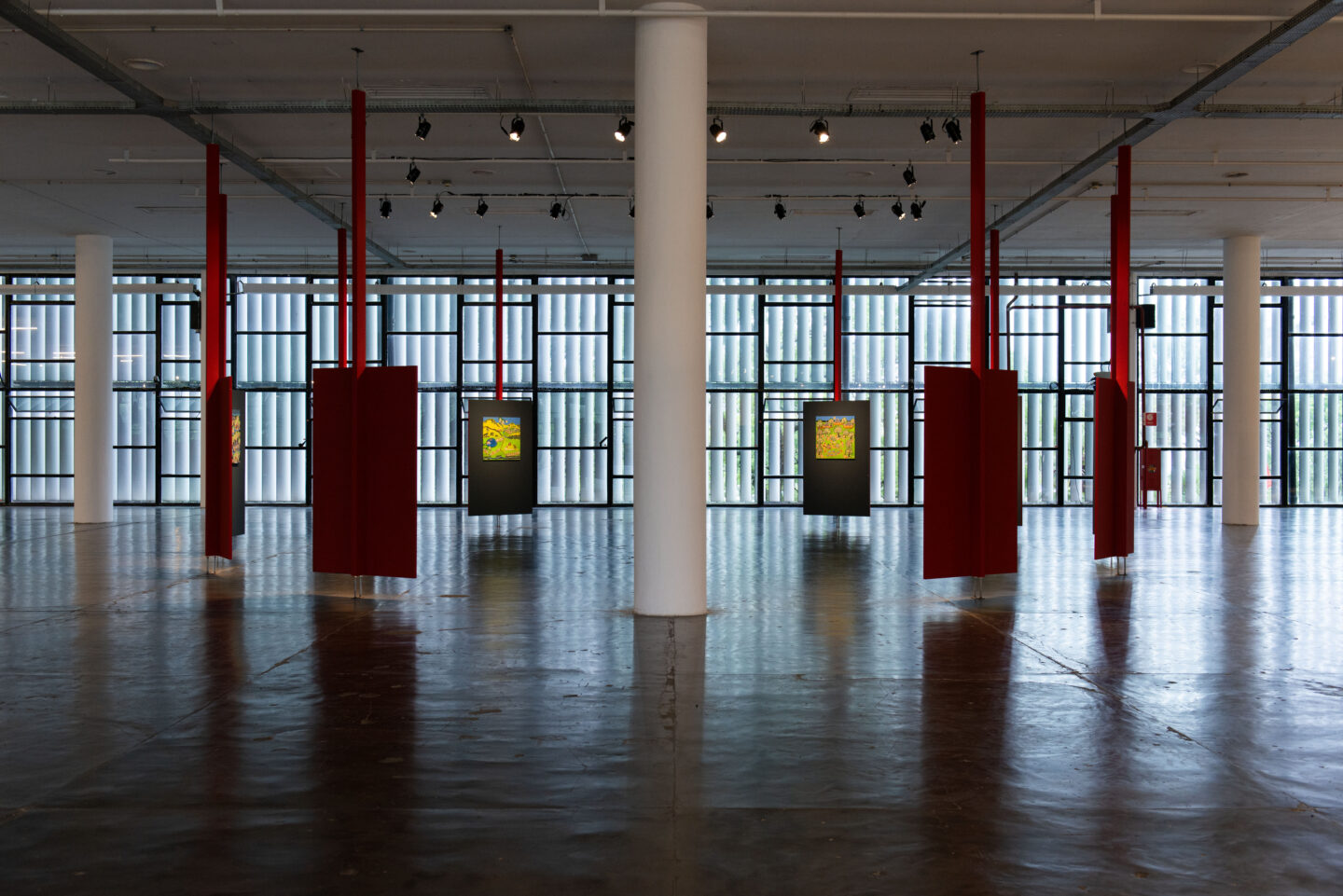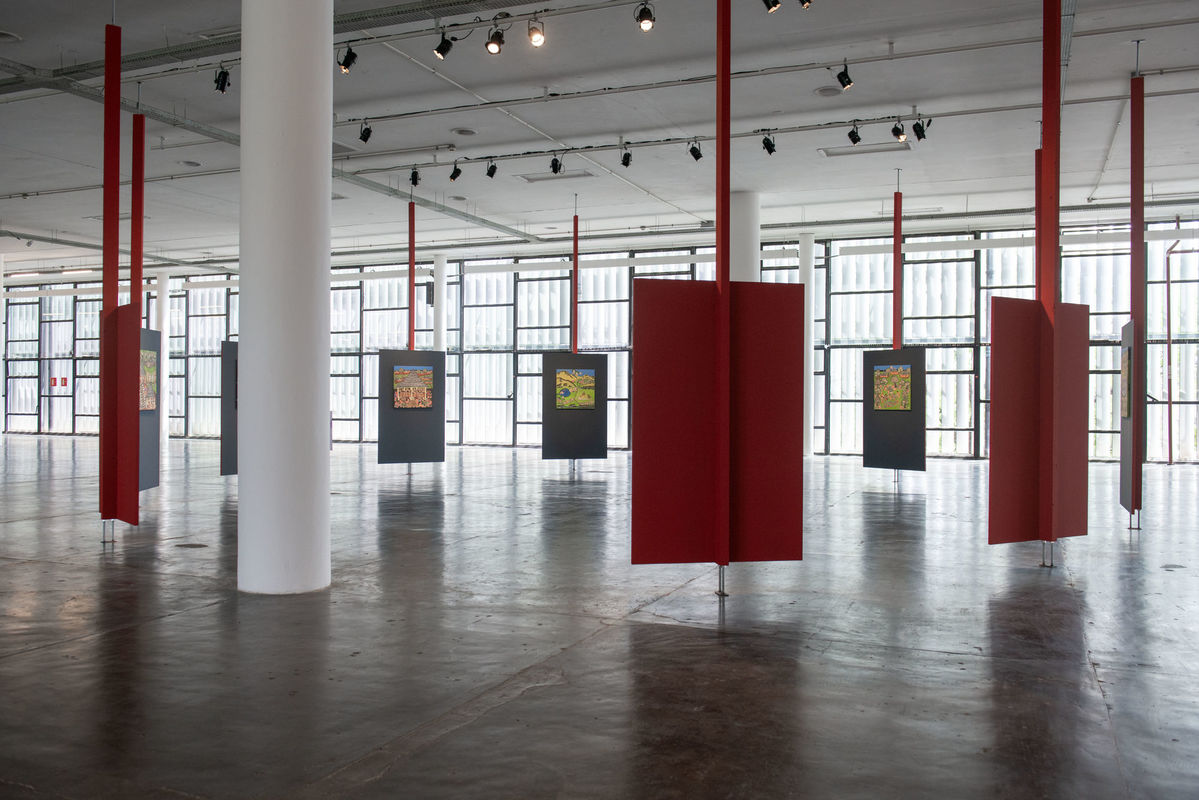
Carmézia Emiliano
The vibrant colors of Carmézia Emiliano’s paintings bring to life the daily existence of the Macuxi peoples, their rites, myths, work, and nature. Her stylistic vigor affirms a unique culture that developed in the region of Monte Roraima and contrasts with the reality of its surroundings, marked by conflicts with mining and the explosion of migration.
Carmézia grew up in the region of the Raposa Serra do Sol Indigenous land. In the late 1980s, she moved to Boa Vista and began her painting practice. Her inspiration always comes from the memory of life in the community, continuously reinforcing her ties with her ancestry.
The affirmation of her culture through her canvases is also a form of elaboration of the real and the imagined, in which she develops a poetics of everyday life. Indigenous women are the protagonists in most of Carmézia’s work, which ultimately displays their role and performance in all areas of Macuxi life, whether weaving, preparing beiju, harvesting, producing pottery, bathing in the river, or caring for children. Through her work, the artist thus presents both a commitment to Indigenous struggle as well as highlighting the gender issue, stressing aspects that could go unnoticed in public debate.
When Carmézia paints scenes that evoke the cosmology of her people, she opens up space for the complexity of everyday life that she seeks to show. Good examples are the legend about Monte Roraima (which is said to have come from Wazaká, the Tree of Life) and the legend of Caracaranã, which takes us to the realm of the fantastic. The opening to imagination that the artist’s work provokes is a powerful political manifestation transmitted with subtlety, involving not only the Macuxi, but all native peoples.
pérola mathias
translated from Portuguese by philip somervell
- Vista de obras de Carmézia Emiliano durante a 35ª Bienal de São Paulo – coreografias do impossível © Levi Fanan / Fundação Bienal de São Paulo
- Vista de obras de Carmézia Emiliano durante a 35ª Bienal de São Paulo – coreografias do impossível © Levi Fanan / Fundação Bienal de São Paulo
- Vista da obra Lenda do casal americano de Carmézia Emiliano durante a 35ª Bienal de São Paulo – coreografias do impossível © Levi Fanan / Fundação Bienal de São Paulo
- Vista da obra Festival de panela de barro de Carmézia Emiliano durante a 35ª Bienal de São Paulo – coreografias do impossível © Levi Fanan / Fundação Bienal de São Paulo
- Vista da obra Buritizeiro no lavrado de Carmézia Emiliano durante a 35ª Bienal de São Paulo – coreografias do impossível © Levi Fanan / Fundação Bienal de São Paulo
- Vista da obra Os caçadores [The Hunters] de Carmézia Emiliano durante a 35ª Bienal de São Paulo – coreografias do impossível © Levi Fanan / Fundação Bienal de São Paulo
- Vista da obra Muquiando peixe de Carmézia Emiliano durante a 35ª Bienal de São Paulo – coreografias do impossível © Levi Fanan / Fundação Bienal de São Paulo
- Vista da obra Mulheres colhendo buriti, de Carmézia Emiliano durante a 35ª Bienal de São Paulo – coreografias do impossível © Levi Fanan / Fundação Bienal de São Paulo
- Vista da obra Fazendo rede de Carmézia Emiliano durante a 35ª Bienal de São Paulo – coreografias do impossível © Levi Fanan / Fundação Bienal de São Paulo
- Vista da obra Salgando peixe, de Carmézia Emiliano durante a 35ª Bienal de São Paulo – coreografias do impossível © Levi Fanan / Fundação Bienal de São Paulo
- Vista da obra Assando castanha de caju, de Carmézia Emiliano durante a 35ª Bienal de São Paulo – coreografias do impossível © Levi Fanan / Fundação Bienal de São Paulo
- Vista de obras de Carmézia Emiliano durante a 35ª Bienal de São Paulo – coreografias do impossível © Levi Fanan / Fundação Bienal de São Paulo
- Vista de obras de Carmézia Emiliano durante a 35ª Bienal de São Paulo – coreografias do impossível © Levi Fanan / Fundação Bienal de São Paulo
- Vista de obras de Carmézia Emiliano durante a 35ª Bienal de São Paulo – coreografias do impossível © Levi Fanan / Fundação Bienal de São Paulo
- Vista da instalação de Carmézia Emiliano durante a 35ª Bienal de São Paulo. 19/10/2023 © Levi Fanan / Fundação Bienal de São Paulo
Carmézia Emiliano (Maloca do Japó, RR, Brazil, 1960. Lives in Boa Vista, RR, Brazil) is a pioneering indigenous artist in the contemporary Brazilian scene who has been dedicated to painting since the 1990s. Her works depict themes of Macuxi culture, such as festivals, dances and games associated with the cultivation and consumption of cassava, in addition to portraying their daily lives and landscapes, especially Mount Roraima. The Macuxi are a people who live in the border region between Venezuela, Guyana, and Brazil. They live in the Raposa Serra do Sol Indigenous Land, a place that has been the stage of conflicts with illegal mining. Emiliano had an extensive individual exhibition at MASP (São Paulo, Brazil), among other collective exhibitions.

 Português
Português

